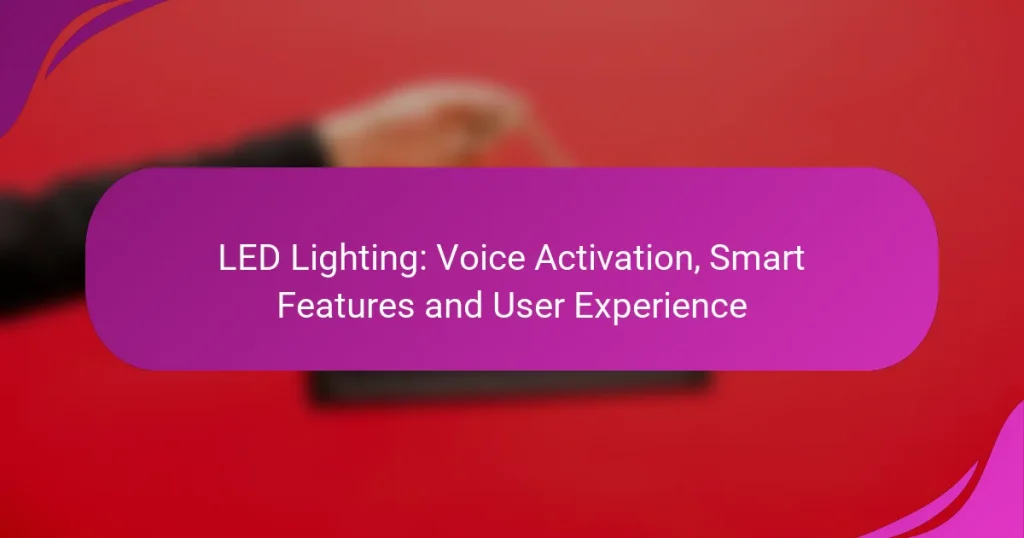LED lighting technology has transformed the way we illuminate our spaces, offering features like voice activation and smart controls that enhance user experience. With the ability to adjust brightness and color through simple voice commands, users enjoy unprecedented convenience and accessibility. These smart features not only streamline lighting management but also promote energy efficiency, making modern living more comfortable and customizable.
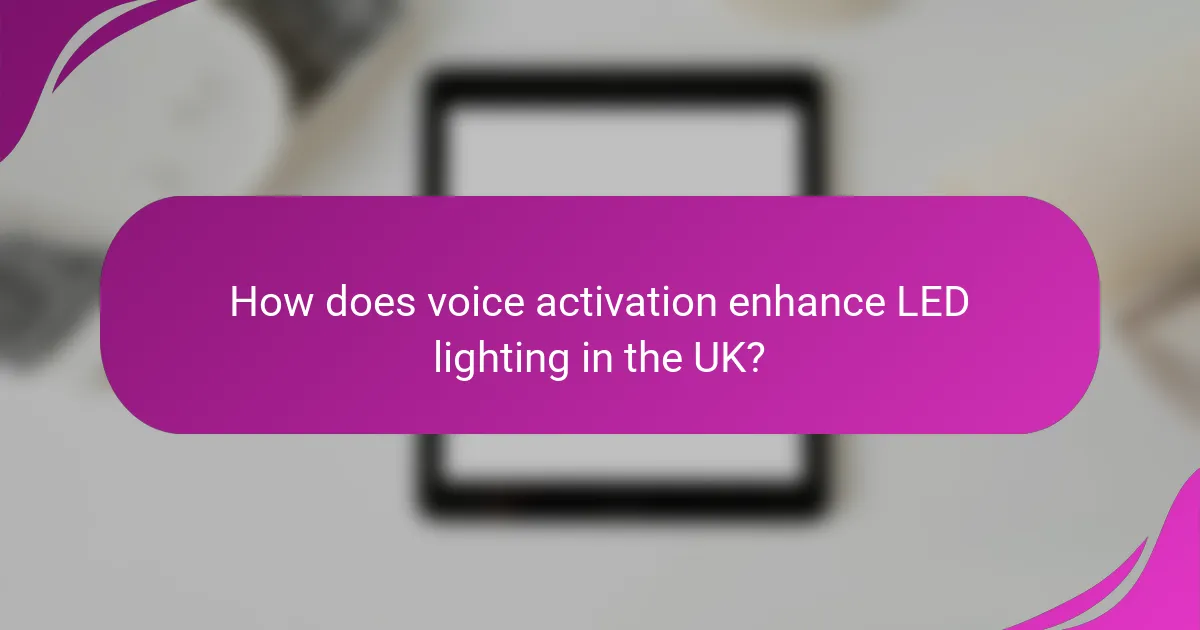
How does voice activation enhance LED lighting in the UK?
Voice activation significantly enhances LED lighting in the UK by allowing users to control their lights hands-free, improving convenience and accessibility. This technology integrates seamlessly with smart home systems, enabling users to adjust brightness, color, and schedules using simple voice commands.
Integration with Amazon Alexa
LED lighting systems that integrate with Amazon Alexa allow users to control their lights using voice commands through Echo devices. Users can easily turn lights on or off, dim them, or change colors by simply asking Alexa, making it a practical choice for busy households.
To set up, ensure your LED lights are compatible with Alexa and follow the manufacturer’s instructions to connect them via the Alexa app. Regular updates to the app enhance functionality, so keep it updated for optimal performance.
Compatibility with Google Assistant
LED lights compatible with Google Assistant enable voice control through Google Home devices, offering similar functionalities as Alexa. Users can issue commands like “Hey Google, turn on the living room lights” for effortless control.
Setting up Google Assistant with your LED lights typically involves linking the lights to the Google Home app. Ensure your Wi-Fi connection is stable to avoid delays in response time when issuing commands.
Control through Apple HomeKit
For Apple users, LED lighting systems that support HomeKit provide a secure way to manage lights via Siri. Users can control their lighting with commands like “Hey Siri, set the bedroom lights to warm white,” enhancing the smart home experience.
To use HomeKit, ensure your LED lights are compatible and add them to the Home app on your iPhone or iPad. This integration allows for automation and remote access, making it easy to manage lighting even when away from home.
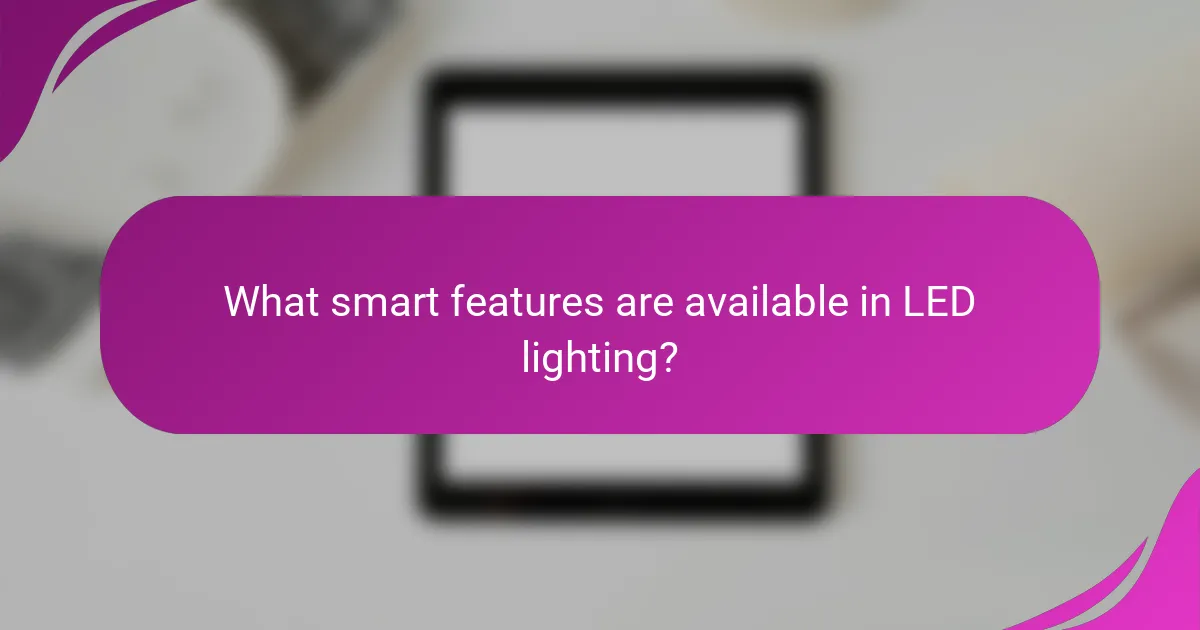
What smart features are available in LED lighting?
LED lighting offers a variety of smart features that enhance user experience, including voice activation, remote control, scheduling, and energy monitoring. These capabilities allow users to manage their lighting more efficiently and conveniently, often through smartphone apps or smart home systems.
Remote control via smartphone apps
Many LED lighting systems can be controlled remotely through dedicated smartphone applications. These apps typically allow users to turn lights on or off, adjust brightness, and change colors from anywhere within range of the internet.
When selecting a smart LED system, consider compatibility with your smartphone’s operating system and whether the app offers intuitive controls. Popular options include Philips Hue and LIFX, which provide user-friendly interfaces and robust features.
Scheduling and automation capabilities
LED lighting can be programmed to operate on a schedule, turning on or off at specific times. This feature is particularly useful for enhancing home security or automating daily routines, such as waking up to gradually brightening lights.
Many systems allow users to set multiple schedules and even create automation scenarios that link lighting with other smart devices, like thermostats or security systems. For example, you can program lights to turn on when your smart door lock is activated.
Energy monitoring features
Some advanced LED lighting systems include energy monitoring features that track electricity usage. This information can help users understand their energy consumption patterns and identify opportunities for savings.
Look for systems that provide real-time data and historical usage reports, which can be accessed via smartphone apps. This feature not only promotes energy efficiency but can also help reduce electricity bills over time.
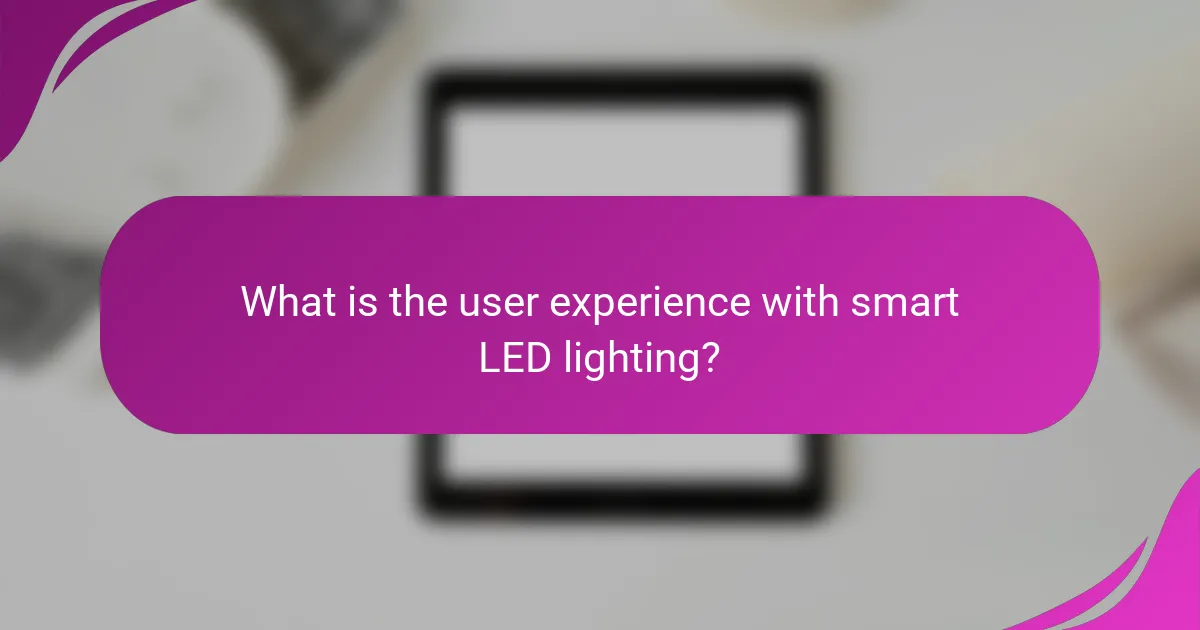
What is the user experience with smart LED lighting?
The user experience with smart LED lighting is generally positive, characterized by convenience, customization, and enhanced control over home lighting. Users appreciate features like voice activation and mobile app integration, which simplify managing lighting preferences.
Ease of installation
Smart LED lighting systems are designed for straightforward installation, often requiring minimal tools. Most products come with clear instructions, and many can be set up in under 30 minutes, making them accessible for DIY enthusiasts.
Some systems utilize standard light sockets, while others may require a hub or bridge for connectivity. It’s essential to check compatibility with existing fixtures and Wi-Fi networks to ensure a smooth setup.
Intuitive app interfaces
The mobile apps for smart LED lighting are typically user-friendly, featuring intuitive layouts that allow for easy navigation. Users can quickly adjust brightness, color, and schedules, often with just a few taps.
Many apps also support voice commands through virtual assistants like Amazon Alexa or Google Assistant, enhancing the overall experience. Regular updates often improve functionality and introduce new features, keeping the user experience fresh.
Customer satisfaction ratings
Customer satisfaction ratings for smart LED lighting are generally high, with many users praising the convenience and energy efficiency of these products. Reviews often highlight the ease of use and the ability to create personalized lighting scenes.
However, some users report issues with connectivity or app performance, which can affect overall satisfaction. It’s advisable to research specific brands and models, looking for those with consistently positive feedback and robust customer support.
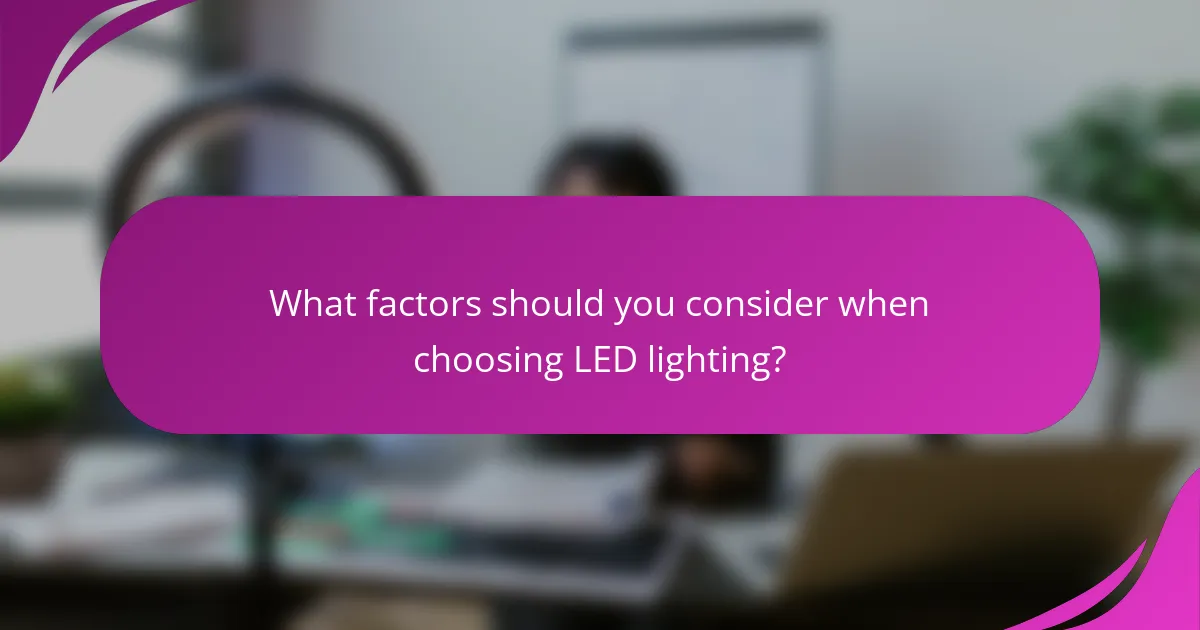
What factors should you consider when choosing LED lighting?
When selecting LED lighting, consider factors such as brand reputation, energy efficiency, and warranty options. These elements can significantly impact performance, cost savings, and overall satisfaction with your lighting choices.
Brand reputation and reviews
Brand reputation plays a crucial role in ensuring quality and reliability in LED lighting. Look for manufacturers with positive reviews and a history of producing durable products. Customer feedback can provide insights into performance and longevity.
Researching brands through consumer reports or trusted online platforms can help you identify which companies consistently deliver high-quality LED lights. Avoid brands with a high number of negative reviews or complaints about product failures.
Energy efficiency ratings
Energy efficiency ratings indicate how much electricity an LED light uses compared to its brightness output. Look for products with high ratings, such as those labeled with ENERGY STAR certification, which ensures they meet strict efficiency guidelines.
Generally, a good LED bulb should consume significantly less energy than traditional incandescent bulbs, often using about 75% less electricity. This not only lowers your utility bills but also reduces your carbon footprint.
Warranty and support options
Warranties and support options are essential when choosing LED lighting, as they reflect the manufacturer’s confidence in their product. A longer warranty period, typically ranging from three to five years, can provide peace of mind and assurance of quality.
Additionally, check if the manufacturer offers customer support for installation or troubleshooting. Reliable support can save you time and frustration if issues arise with your lighting system.
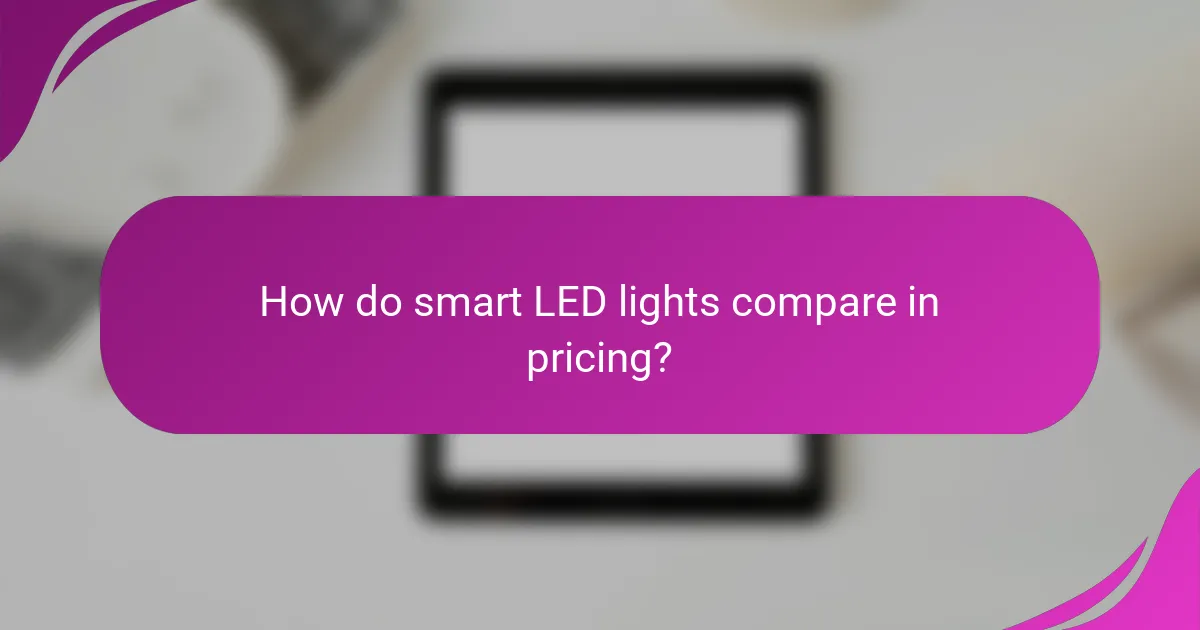
How do smart LED lights compare in pricing?
Smart LED lights typically range from affordable to premium pricing, depending on features such as voice activation and connectivity. Basic models can be quite economical, while those with advanced functionalities may cost significantly more.
Cost of basic models
Basic smart LED lights usually start at around $10 to $20 per bulb. These models often include essential features like remote control via an app and basic scheduling capabilities. They are a great entry point for those looking to upgrade their lighting without a substantial investment.
Pricing for premium features
Smart LED lights with premium features, such as voice activation, color changing, and integration with home automation systems, can range from $30 to $100 or more per bulb. Brands that offer enhanced functionalities often provide additional benefits like improved energy efficiency and longer lifespans. Investing in these models can enhance the overall user experience and convenience.
Long-term savings on energy bills
While the initial cost of smart LED lights may be higher, they can lead to significant savings on energy bills over time. Smart LEDs typically use up to 80% less energy than traditional incandescent bulbs, which can translate to lower monthly electricity costs. Additionally, features like scheduling and remote control allow users to optimize their lighting usage, further reducing energy consumption.

What are the latest trends in LED lighting technology?
The latest trends in LED lighting technology focus on enhanced user experience through voice activation, smart features, and energy efficiency. Innovations in connectivity and automation are making LED lighting more adaptable and user-friendly, catering to both residential and commercial needs.
Voice Activation in LED Lighting
Voice activation is increasingly integrated into LED lighting systems, allowing users to control their lights hands-free. This feature is commonly compatible with smart home assistants like Amazon Alexa, Google Assistant, and Apple HomeKit.
To utilize voice activation, users typically need to connect their LED lights to a compatible hub or app. Once set up, simple commands can adjust brightness, color, or even turn lights on and off, enhancing convenience and accessibility.
Smart Features of LED Lighting
Smart features in LED lighting include remote control, scheduling, and integration with other smart home devices. Users can manage their lighting through mobile apps, enabling them to customize settings based on personal preferences or routines.
For example, smart LED bulbs can be programmed to change colors or dim at specific times, which can help create ambiance or save energy. Many systems also offer energy monitoring, allowing users to track usage and optimize efficiency.
User Experience with LED Lighting
User experience with LED lighting is significantly enhanced by intuitive interfaces and customizable options. Many modern LED systems offer user-friendly apps that simplify setup and control, making it easy for anyone to adjust their lighting environment.
When selecting LED lighting, consider factors such as compatibility with existing smart home systems, ease of installation, and the range of features offered. Avoid overly complex setups that may lead to frustration; instead, opt for systems that provide straightforward functionality and reliable performance.
